Revised 14 January 2022
Accepted 25 November 2022
Available Online 10 January 2023
- DOI
- https://doi.org/10.55060/s.atssh.221230.040
- Keywords
- Monument
Memorial
Sculpture
Composition
Public space
Architectural environment
Ensemble - Abstract
This article considers new monuments, memorials and monumental sculptures which appeared in the first quarter of the 21st century in Nizhny Novgorod. Describing the volumetric composition of a monument, the author is focusing on its role in the formation of public spaces. Depending on their town-planning place in the city historic-architectural environment, the monuments are typologized as follows: on a square, in a park, in the Nizhny Novgorod Kremlin, in the open area of the Strelka. The author concludes that the monument plays the role of an organizing principle in the public space in which it is located, as well as the role of a binding, synthesizing element for individual fragments of the urban environment. The article is accompanied by the author's photos.
- Copyright
- © 2022 The Authors. Published by Athena International Publishing B.V.
- Open Access
- This is an open access article distributed under the CC BY-NC 4.0 license (https://creativecommons.org/licenses/by-nc/4.0/).
1. INTRODUCTION
Nizhny Novgorod, the largest Russian city, known since ancient times for its natural and man-made riches, has preserved from pre-revolutionary times the only monument: an obelisk erected in 1828 in the Nizhny Novgorod Kremlin in honor of the leaders of the people's militia of 1612 Kuzma Minin and Dmitry Pozharsky. All other existing monuments appeared much later. In 1927 a monument to V.I. Lenin was opened in Sormovo, in 1930 a monument to the Heroes and Martyrs of the 1905 Revolution, in 1940 a monument to V.P. Chkalov, in 1952 a monument to Maxim Gorky, in 1965 a memorial complex of Eternal Flame in the Nizhny Novgorod Kremlin, in 1970 a monument to V.I. Lenin in Lenin Square, in 1987 a monument to P.N. Nesterov, in 1989 a monument to Kuzma Minin in Minin and Pozharsky Square, in 1995 a monument to St. George the Victorious…
In the first quarter of the 21st century, many monuments appeared in the city, reflecting the importance of the participation of Nizhny Novgorod residents in the life of the country and the response to important events. These are: a monument to Minin and Pozharsky in the National Unity Square; the founder of the city, Prince Georgy Vsevolodovich, and his spiritual mentor Simon; valiant home front workers in the Nizhny Novgorod Kremlin; memorial complexes to Nizhny Novgorod residents who died in Afghanistan and Chechnya, in the park “Shveytsariya”; victims of the Chernobyl disaster in Staroyarmarochny passage; Peter the Great on the Nizhnevolzhskaya Embankment; Alexander Nevsky on the Strelka.
Thus, the role of the monument as organizer of an open public space was formed in the ancient city quite recently: in the Soviet and post-Soviet era. Playing an important role in patriotic upbringing, with a common memorial significance and a different urban planning location, all these objects of different sizes and scales are a unifying beginning for a diverse environment. Like some “keystones” they hold together the entire urban environment, ensuring its integrity and clear perception by different recipients [1].
“The monument is a monument of considerable size, suggesting a large-scale ensemble artistic solution” [2]. Already this definition indicates the inextricable connection of the monument with the public space that it forms.
Scientists constantly point out that the monument should be located “in a real historical space” [3].
“To give space as an independent living organism, it is necessary to enrich it with changing aspects, constantly new images of its embodiment” [4].
“In this integrity, which is formed by the environment that connects the material environment, the behavior of people, the culture of different eras, there is also art. His works – monumental, connected with a certain place and its character, or easel, forming a kind of self-sufficient world within its own limits – are perceived correlated with the forms of the environment and the semantic context in which this environment develops” [5].
“The monument is designed to accumulate a spatial environment and establish direct communication with the viewer in the name of inoculating an individual with a common idea” [6].
“The images of history are perhaps the most anticipated and developed context of the work of an architect, designer or artist. At the same time, this resource has a pronounced “educational” character, while maintaining faith in the value of a material artifact and respect for the memory of the lost material” [7].
Let's trace the role of Nizhny Novgorod monuments in the urban environment by considering individual monuments of the first quarter of the 21st century.
2. MONUMENT AND SQUARE
The story of the monument to K. Minin and D. Pozharsky should be started with the history of the National Unity Square. This square is a special place for the Nizhny Novgorod citizens and for Russia as a whole. Its significance goes deep into history: right here Kuzma Minin assembled the people's militia, which was destined to play a key role in Russian history. This place is a certain hinge in which the most contrasting moments typical for our city converge: the mountain and the river; the Kremlin and the posad; transport and pedestrian; the old and the new; the connection of the Upper and Lower suburbs, emphasized by a pronounced relief; the connection of the cult and business – the Church of the Nativity of John the Baptist and the prospects of Rozhdestvenskaya Street, which was historically the Nizhny Novgorod city with its banks, trading and apartment buildings; the busy transport Zelensky Hill Road and the path to the Kremlin – pedestrian Ivanovsky Hill Road; the history and modernity – the beautifully readable “necklace” of the Nizhny Novgorod Kremlin, and a large shopping center.
In 2004, NNGASU headed by rector academic V.V. Naydenko developed a concept for the development of the Zapochaine territory, one of the important nodes of which was the National Unity Square. In 2004, sculptor Zurab Tsereteli made a copy of I.P. Martos’ monument to Minin and Pozharsky, and the Moscow government presented it to Nizhny Novgorod. Exactly this location was chosen for installation of the monument, although until mid-2004 it had been a half-forgotten site with a distorted view of the Church of the Nativity of John the Baptist (restored in 2005), and a spontaneous parking lot. The installation of a new monument just in this place was inspired by the painting “Minin’s Appeal to Nizhny Novgorod Residents” by K. Makovsky.
The monument to K. Minin and D. Pozharsky, a replica of the monument by I.A. Martos (sculptor Z. Tsereteli), architects A. Gelfond, Yu. Kartsev, M. Dutsev, 2005, is located in the center of a small circular base, on a 1.5m hill with access to the monument from four sides (Fig. 1). The bronze sculpture on a pedestal, lined with slabs of pink granite, is placed parallel to the Kremlin hill, facing the main viewpoint: the entrance to the Zelensky Hill Road.
The memorial sign “Victory of 1945” is a memorial complex dedicated to the victory of the Soviet people in the Great Patriotic War (architect S. Timofeev, 2000) located in the Prioksky district in Marshal Zhukov Square. A city competition for a memorial was announced in 1999 on the initiative of the chief architect of the city Alexander Kharitonov. The winner was the project by architect Sergey Timofeev. He tells about his creative idea: “The square is a large space that needed to be organized with the help of exactly this memorial. So, the idea of a circle that “holds” the space has appeared. A round composition on a low three-stage podium with an eternal flame in the center was inspired by the theme of a stone flower. A waterfall was also conceived (that was not implemented). The concept is based on two metaphors: the bitterness of war and the joy of victory”. The walls of the breastwork symbolize the bowed banners and, at the same time, the military operations that were conducted in the destroyed cities. The monument is lined with granite slabs; the color scheme is based on the idea of contrast: black walls of the breastwork, white columns (those are lamps at the same time), and red pedestals (Fig. 2).
Later, in 2015, a monument to marshal G.K. Zhukov was erected in the square (sculptor Aleksey Schitov, architect Sergey Shorokhov). The author of the project, architect S. Shorokhov says: “We have chosen the imagery of this monument to match the scale of the personality and character of Georgy Konstantinovich Zhukov: solid, straightforward, standing firmly and unshakably on the ground. Hence, there is a simple, massive silhouette: a powerful bronze figure of the marshal on a laconic and rough pedestal made of large stone blocks [8].
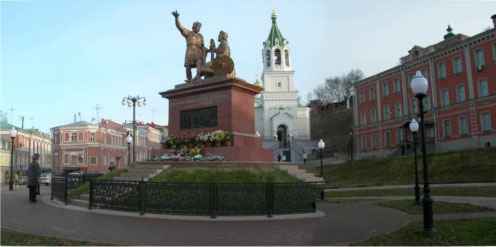
Monument to K. Minin and D. Pozharsky; replica of the monument by I.A. Martos (sculptor Z.K. Tsereteli). Architects: A. Gelfond, Yu. Kartsev, M. Dutsev (2005).
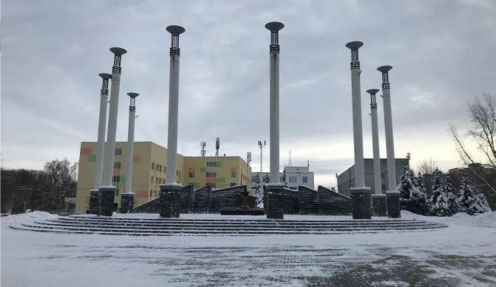
Memorial “Victory of 1945” in Marshal Zhukov Square. Architect: S. Timofeev (2000).
3. MONUMENTS AND ENSEMBLE OF THE NIZHNY NOVGOROD KREMLIN
The most famous monument of monumental art in the Nizhny Novgorod Kremlin is an obelisk in honor of the leaders of the People's militia of 1612 Kuzma Minin and Dmitry Pozharsky (sculptor I.P. Martos, architect A. Melnikov, 1828). The Eternal Flame Memorial Complex is located next to it. These objects are perceived as a single ensemble, and they offer a beautiful view of the Volga and the Trans-Volga distances. However, this article is about the new monuments of the first quarter of the 21st century.
The monument to Prince Georgy Vsevolodovich and Bishop Simon of Suzdal (sculptor V. Purikhov, architect V. Voronkov) was installed on the territory of the Nizhny Novgorod Kremlin in front of the southern facade of the ancient Mikhailo-Arkhangelsk Cathedral of 1631, which is a cultural heritage object of federal significance. The monument was opened in 2008 and is dedicated to Nizhny Novgorod founder Prince Georgy Vsevolodovich and his spiritual mentor, St. Simon of Suzdal, who blesses the place on which the city was built. Having given his life for the Fatherland, the Grand Duke was canonized in 1643.
The sculpture is a two-figure composition, which, according to the idea of the authors (sculptor Viktor Purikhov, architect Vadim Voronkov) symbolizes the unity of worldly and spiritual life principles. The sculpture’s location against the background of the most ancient temple of the Nizhny Novgorod region has a semantic meaning: the bronze figures should be perceived as coming from the Orthodox Church towards the visitors of the Nizhny Novgorod Kremlin. The height of the monument together with the pedestal is 7.5m. The figures in the paired sculptural group are designed on contrast, which does not interfere with its holistic perception. The bishop's raised right hand, with which he blesses the new city, is located in the geometric center of the monument, which gives the idea a special meaning. The bronze figures are mounted on a pedestal of prismatic shape, lined with slabs of light gray granite. Two thin vertical niches and the upper belt are made of black granite. A granite pedestal on a low plinth narrows upwards, giving dynamics to the overall composition. At the bottom on the front side of the pedestal, on a light gray volume protruding from a dark gray pedestal, there is a bronze cartouche with the inscription: “To the founder of the city, St. Grand Duke Georgy Vsevolodovich and his mentor, St. Simon from Nizhny Novgorod citizens” (Fig. 3).
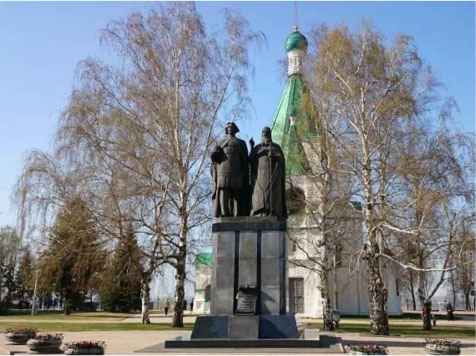
Monument to Prince Georgy Vsevolodovich and Bishop Simon of Suzdal. Sculptor: V. Purikhov, architect: V. Voronkov (2008).
The memorial sign “To the Gorky valiant home front workers” (sculptors A. Schitov, A. Simonov, K. Sharonov, architect S. Timofeev) was installed in the Nizhny Novgorod Kremlin in 2020 opposite to the exhibition of weapons along the axis with the monument to Georgy the Victorious (sculptor T. Kholueva, architect A. Kholuev, 1995). It became part of the memorial complex “Gorkovites to the front”.
The task to make a memorial sign to the home front workers for the 75th anniversary of Victory in the Great Patriotic War of 1941–1945 was set in February 2020. Such an idea has existed for quite a while, and the time has come for its implementation. At first, it was assumed that it would be a small sign, but then they decided to make a developed composition. Chief architect of the Nizhny Novgorod region Sergey Gennadevich Popov identified the place, on the axis of the monument to Georgy the Victorious.
Architect S.A. Timofeev proceeded in his search from the original composition of the sculptor. First, sculptor Aleksey Schitov made a composition that included figures of an old man, a boy, a draftsman with a drawing board, and a mechanism: a stylized gear. S. Timofeev began to develop the composition, he sculpted model variants himself. According to the architect, such a significant theme predetermines a female figure to be included in the memorial, as exactly women worked valiantly in the home front when men fought on the battle fronts of the Great Patriotic War. As a result, a composition was formed with three bronze figures: a woman, an elderly man and a boy against the background of flags and a transparent wheel symbolizing wartime equipment that was manufactured at the Gorky factories. The pedestal is made of solid granite: it is a low truncated pyramid on a prismatic podium. Such a deliberate approach of the figures to the viewer symbolizes the simplicity of everyday selfless work.
The monument was built in the shortest possible time: two months passed from the sketch to the embodiment! The authors showed great perseverance and creative persistence. Sculptor A. Schitov together with assistants sculpted figures in Moscow, casting was carried out in different cities. The pedestal was made of stones that were available in Yaroslavl at the factory. Sculptor A. Schitov said: “I wanted to express the atmosphere of that time, so that those who would look at this monument would have a sense of that era. For a very long time we chose both, the color of bronze and stone. When I was working on it, I was wondering what the factories of that era looked like … There was a feeling of power: the work in the destroyed workshops had not stopped for a day”.
On 2 July 2020, Nizhny Novgorod was awarded the honorary title of the Russian Federation “City of Labor Valor”, and the opening of the monument was timed to coincide with this important event.
The monument to Peter the Great (sculptor Aleksey Schitov, architect Sergey Shorokhov, 2014) is located on the Nizhnevolzhskaya Embankment, in the square in front of the Conception Tower of the Nizhny Novgorod Kremlin. The monument is an accent on this section of the embankment, organizing an outpost in front of the entrance to the Kremlin (Fig. 4).
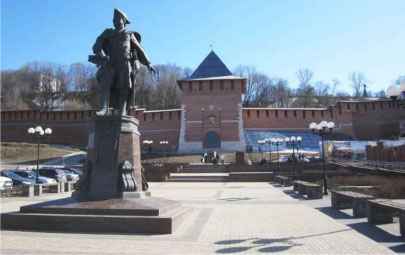
Monument to Peter the Great. Sculptor: A. Schitov, architect: S. Shorokhov (2014).
The bronze figure depicts Peter the Great in rapid motion, looking at the Volga distances. In a cloak fluttering behind his back, in a cocked hat, with a walking stick in a baldric, and with a scroll of a new decree on the Nizhny Novgorod province in his hand, the emperor walks as if inspired by a bold idea.
The author of the project, architect Sergey Shorokhov, says: “Being aware of the responsibility of designing in such a place, we tried to solve two main tasks: to get into the scale and into the stylistic context of the environment. When choosing dimensions of the monument, for a long time we determined both, its overall height and the proportional ratio of the figure and the pedestal. The distance to the pedestrian zone of the embankment was taken as the main distance of perception. Based on this, we determined the proportions at which the figure of Peter, on the one hand, would be high enough not to visually merge with the cascade of steps of the square, and on the other hand, would not overlap the gate icon on the Conception Tower”. As a result, the height of the bronze statue is 3.7m and of the pedestal 3m. The pedestal is mounted on a square two-stage granite podium. The transitional elements from the podium to the pedestal are four large dark volutes on its sides, made of concrete. The pedestal is designed in the form of an octagonal truncated pyramid, the slope of its faces corresponds to that of the walls of the Ivanovskaya Tower. This form was chosen so that the silhouette of the monument would look organically against the background of the Kremlin. The pedestal is lined with slabs of Indian granite of dark red-brown color. The pedestal ends with a developed profiled entablature of dark concrete. On the front side of the pedestal is a dark cartouche topped with the coat of arms of the Nizhny Novgorod region. To type the text of the decree placed on the cartouche, the font of Peter's times was used.
4. MONUMENTS IN PARKS
The memorial complex to Nizhny Novgorod citizens who died in Afghanistan and Chechnya (sculptor I. Lukin, architect S. Timofeev, 1994, opening 2002) is located in the park “Shveytsariya” on the high bank of the Oka River on the central alley, and is installed along the axis of the main entrance to the park.
The first architectural and spatial solution of the memorial was developed by sculptor Ivan Lukin and employees of the creative workshop of architect V. Bykov. Initially, in the center of the composition an angel supporting a dying warrior was designed. It is interesting that S. Timofeev, according to his story, drew his idea immediately at the city council dedicated to this object. It was formed under the impression of the desert, the monuments of Central Asia, the architecture of Khiva, Samarkand. It seems, that the tall column with a bronze figure of an angel supporting a mortally wounded warrior on top of it, is surrounded by four stone “candles”. Between these elements, very narrow ascents to the platform are designed, which symbolize narrow streets of eastern cities. At the same time, the composition evokes associations with five-domed churches, only not with bulbous, but with hemispherical completions. Developed on metaphors and reminiscences and having a strong emotional impact, the idea was finally approved and implemented (Fig. 5). All elements of the monument are made of solid light granite, which gives the object materiality and monumentality.
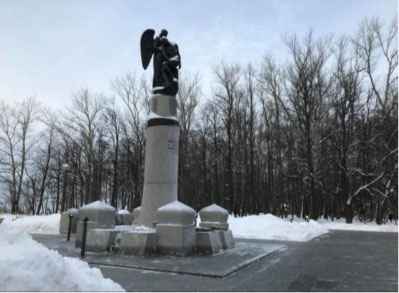
Memorial complex to Nizhny Novgorod citizens who died in Afghanistan and Chechnya. Sculptor: I. Lukin, architect: S. Timofeev (project 1994, opening 2002).
5. MONUMENT AND OPEN SPACE
The monument to Aleksandr Nevsky, sculptor A. Kovalchuk, is installed next to Aleksandr Nevsky Cathedral on the Strelka along the axis of the apse of the southern facade of the temple. The monument was erected for the 800th anniversary of Nizhny Novgorod and was opened on 30 July 2021. A monumental bronze equestrian statue on a bronze plinth is mounted on a rectangular pedestal. The total height of the monument is 13m, the height of the sculpture itself is 6m. Such proportions work to create a whole and expressive image. The sculptor depicted a young prince in combat clothes with his head uncovered. The rider seemed to freeze in thought before the beauty of the panorama of the mountainous part and the Kremlin hill. The pedestal is lined with slabs of dark cherry granite. It is designed in strict shapes and proportions, and it has a developed profiled base and entablature. The “taken out” corners emphasize the self-value of each facade. On the facade facing the river, the inscription is made in bronze letters: “Holy Prince Aleksandr Nevsky” (Fig. 6). On the side facades of the pedestal, in niches with perspective frames and semicircular completions, there are bronze cartouches depicting scenes from the life of the prince.
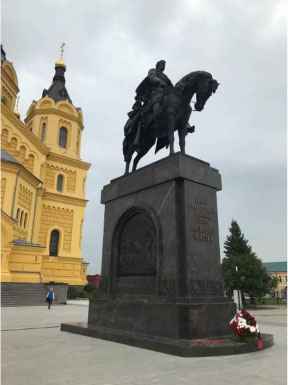
Monument to Aleksandr Nevsky. Sculptor: A. Kovalchuk (2021).
6. CONCLUSION
Nizhny Novgorod is a unique city in terms of visual spatial relationships, individual places in the city have “limitless” characteristics of space. From the viewing platform near Georgievskaya Tower of the Kremlin, in the center of a large city, the viewer sees the Trans-Volga distances with the prospect of fields and forests stretching into infinity, as if untouched nature. From the left bank of the Oka River the viewer observes an ascending mountain with historically developed built-up area, allowing to trace the periods of development of Nizhny Novgorod architecture. At the same time, open public spaces are dispersed in Nizhny Novgorod, they do not constitute a continuous network.
The monument plays the role of an organizing principle in the public space in which it is located, as well as the role of a binding, synthesizing element for individual fragments of the urban environment. Regardless of its physical parameters and the kind of place it forms – the chamber space of a small square, or it designates the generic characteristics of Nizhny Novgorod, providing visual connection of Zarechnaya and upland parts – the monument is the semantic dominant in the organization of space. This is mainly due to the fact that a monument to a historical person or historical event is always named, and named objects are perceived differently than unnamed ones. Ideological and psychological aspects, historical, literary and other contexts, the legend of creation and existence ensure the viability of the public space designated by the work of monumental sculpture.
This is the living environment of the city, but not a museum of monumental sculpture, though in practice such a variant of its existence is also known. For instance, the “Muzeon” park in Moscow is the park of sculpture and monuments that have lost their place. It is a special artificial museum environment, organized in full accordance with the name. The sculptures are exhibited there, and do not live their own urban life. Nevertheless, for the monument, the place, the urban planning location where it was created by the authors – sculptors and architects – as well as the urban environment formed around it, are very important.
A separate issue that is beyond the boundaries of this article is the urban sculpture that appeared in the streets of Nizhny Novgorod, namely Bolshaya Pokrovskaya Street and Rozhdestvenskaya Street. Demonstrating individual genre scenes, it plays its role in the urban environment, in no way correlated with the role of monumental sculpture.
The monuments depicted on the map of the city demonstrate an integral spatial network, the cores of which are fixed by them. Corresponding to each other, these objects create a historical, cultural and cognitive framework [9], the movement along which allows a person to explore Nizhny Novgorod through images of its significant personalities.
REFERENCES
Cite This Article

TY - CONF AU - Anna Gelfond PY - 2023 DA - 2023/01/10 TI - Nizhny Novgorod Monuments of the First Quarter of the 21st Century: Their Role in the Architectural Environment BT - Proceedings of the 4th International Conference on Architecture: Heritage, Traditions and Innovations (AHTI 2022) PB - Athena Publishing SP - 301 EP - 306 SN - 2949-8937 UR - https://doi.org/10.55060/s.atssh.221230.040 DO - https://doi.org/10.55060/s.atssh.221230.040 ID - Gelfond2023 ER -









